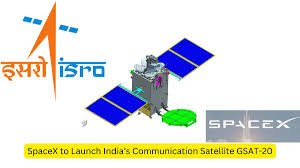SpaceX to Launch India’s Communication Satellite GSAT-20
Introduction to GSAT-20 Satellite Launch
India is set to enhance its communication capabilities with the launch of the GSAT-20 satellite, which will be carried into space by the private space agency, SpaceX. This significant milestone in India’s space exploration comes as part of the country’s ongoing efforts to expand its satellite network and improve broadband connectivity. The GSAT-20 is poised to provide advanced communication services and strengthen India’s presence in the global satellite sector.
GSAT-20 Satellite: Overview
The GSAT-20 satellite is an advanced communication satellite developed by the Indian Space Research Organisation (ISRO). It is designed to meet the growing demands for telecommunication, television broadcasting, and broadband services across India. Equipped with high-power communication transponders, GSAT-20 will provide critical infrastructure to support a wide range of applications, including direct-to-home (DTH) television services and satellite-based internet services in remote areas.
The satellite will be launched aboard SpaceX’s Falcon 9 rocket, a reusable spacecraft known for its cost-effectiveness and reliable performance. This partnership with SpaceX marks a strategic move towards reducing launch costs and increasing the frequency of satellite launches for India.
Importance of GSAT-20 for India’s Communication Sector
The GSAT-20 will play a pivotal role in strengthening India’s communication infrastructure. With the growing demand for high-speed internet and reliable connectivity, particularly in rural and underserved regions, GSAT-20 is expected to provide much-needed bandwidth to support educational, medical, and economic activities. By improving broadband penetration and satellite-based communications, this mission will bridge the digital divide in India.
Additionally, GSAT-20 will contribute to India’s self-reliance in space technology and satellite communication, reducing the dependency on foreign satellites for crucial services.
Why This News is Important
Advancement in India’s Communication Infrastructure
The GSAT-20 satellite launch is a major step towards advancing India’s communication infrastructure. The satellite is designed to meet the demands of telecommunication, internet, and DTH services. This launch will help India bolster its efforts to provide uninterrupted, high-quality connectivity, especially in rural and remote areas where terrestrial networks are insufficient.
Boost to Space Industry and Self-Reliance
The partnership between ISRO and SpaceX not only demonstrates India’s growing capabilities in satellite technology but also underscores the importance of international collaborations in space missions. The use of SpaceX’s Falcon 9 rocket for this launch reduces costs while ensuring that India has access to state-of-the-art space launch technology. This move also exemplifies India’s commitment to achieving greater self-reliance in space operations, a key objective for the nation’s space program.
Enhancing India’s Global Space Presence
India has long been a major player in the global space industry, and the GSAT-20 launch will further solidify the country’s position as a leader in space exploration and satellite communication. The GSAT-20 satellite will not only enhance national communication capabilities but will also improve India’s reputation in satellite technology and space exploration globally.
Historical Context: Background Information on GSAT Satellites
India’s Satellite Development Program
India’s journey in satellite communication began with the launch of its first satellite, Aryabhata, in 1975. Over the decades, India has consistently enhanced its space capabilities through a series of successful satellite launches. The GSAT series, initiated in the early 2000s, has played a crucial role in meeting the growing demand for satellite communication services in India. Each successive satellite in the GSAT series has been equipped with more advanced technology to support the country’s telecommunications, broadcasting, and internet infrastructure.
Significance of GSAT-20 in the Series
The GSAT-20 satellite is the latest in a long line of Indian communication satellites. It will build upon the success of earlier satellites like GSAT-6, GSAT-12, and GSAT-15, which have provided critical services in communication, broadcasting, and remote sensing. GSAT-20 will expand the capacity of India’s satellite communication network, further improving broadband access across the nation.
Key Takeaways from “SpaceX to Launch India’s Communication Satellite GSAT-20”
| Serial No. | Key Takeaway |
|---|---|
| 1 | GSAT-20 is an advanced communication satellite developed by ISRO. |
| 2 | The satellite will be launched by SpaceX’s Falcon 9 rocket. |
| 3 | GSAT-20 will provide essential communication services like DTH and broadband. |
| 4 | The satellite launch aims to improve connectivity in rural and remote areas. |
| 5 | This mission strengthens India’s self-reliance in space technology. |
Important FAQs for Students from this News
What is the GSAT-20 satellite?
- GSAT-20 is an advanced communication satellite developed by ISRO. It is designed to improve broadband services, telecommunication, and DTH broadcasting across India.
Which company is launching the GSAT-20 satellite?
- The GSAT-20 satellite will be launched by SpaceX using their Falcon 9 rocket.
How will the GSAT-20 satellite benefit India?
- The satellite will enhance communication services, provide better broadband connectivity, especially in rural and remote areas, and improve the country’s self-reliance in space technology.
Why is the GSAT-20 launch significant for India’s space program?
- This launch marks a key milestone in India’s space exploration efforts. It strengthens India’s space communication infrastructure and reduces the dependency on foreign satellites for crucial services.
What are the key features of the GSAT-20 satellite?
- GSAT-20 is equipped with high-power communication transponders designed to enhance telecommunication, broadcasting, and broadband services across the nation.

